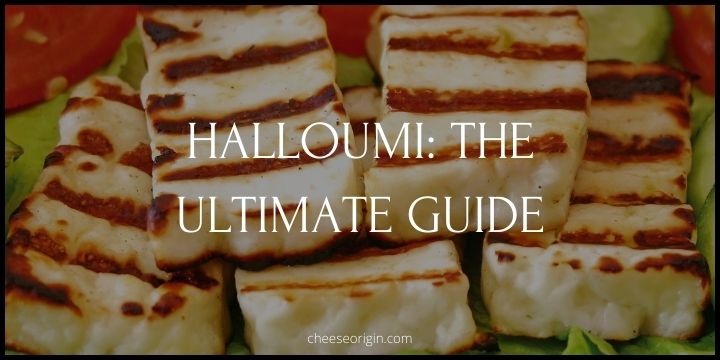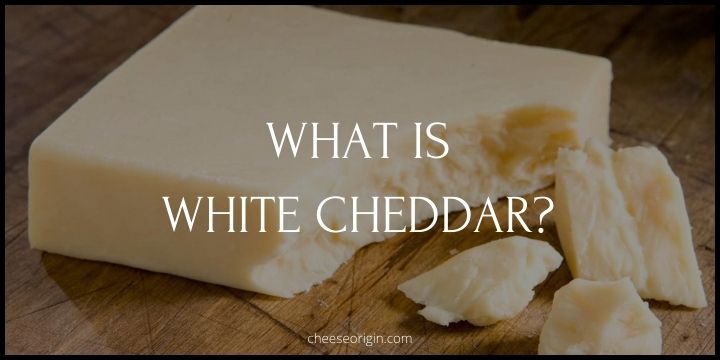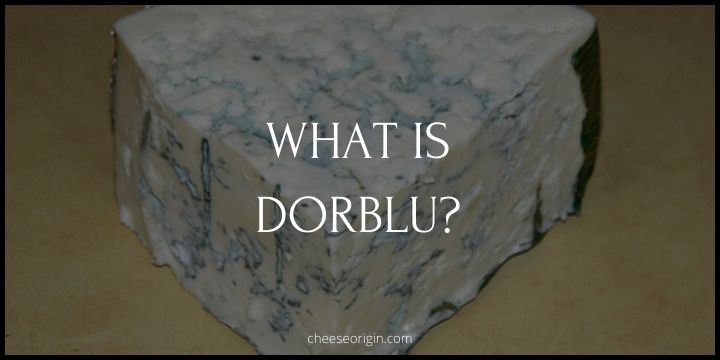What is Gouda? The Golden Glory of Dutch Cheese
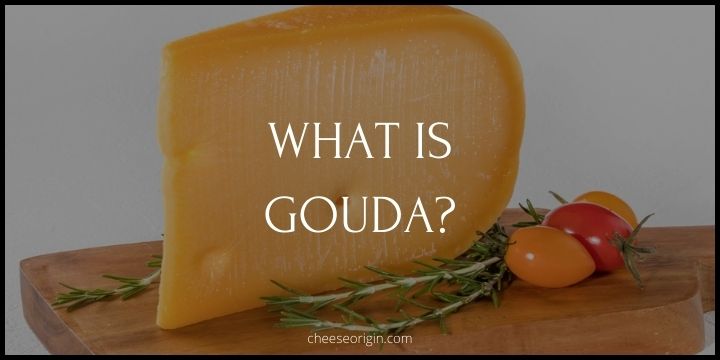
Welcome to our deep dive into the world of Gouda – the golden glory of Dutch cheese. This delightful dairy product has been winning over taste buds for centuries with its creamy texture, versatile flavor profile, and unique aging process.
Whether you’re a seasoned fromage fan or a beginner in the cheese sphere, we invite you to join us on a journey from the verdant pastures of the Netherlands to your cheese board.
We’ll delve into the history, production, and culinary applications of Gouda, and by the end of this exploration, you’ll understand why this cheese is so much more than just a topping on your burger or a component in your fondue.
Quick Facts About Gouda
| Fact | Detail |
|---|---|
| Origin | Gouda is named after the city of Gouda in the Netherlands, where it was historically traded. |
| Cheese Family | Gouda is a semi-hard to hard cheese. |
| Milk Source | Traditionally, Gouda is made from cow’s milk, but variations can include goat’s or sheep’s milk. |
| Ageing Process | Gouda can be aged from a few weeks (young Gouda) to over two years (very old Gouda). The aging process affects the color, flavor, and texture of the cheese. |
| Flavor Profile | Young Gouda is typically mild, creamy, and slightly sweet, while aged Gouda becomes harder, darker, and develops a caramel-like, nutty flavor. |
| Color | Gouda cheese is typically yellow to amber in color, depending on its age. |
| Rind | The rind is usually covered in wax, which can be different colors to signify the age of the cheese. |
| Pairings | Gouda pairs well with fruit, nuts, dark chocolate, and a variety of wines and beers. |
| Nutrition | It’s a good source of protein, calcium, and vitamins A and B12. |
| Popular Uses | Gouda is versatile and can be used in a variety of dishes, including sandwiches, pasta, soups, and cheese boards. |
What is Gouda?
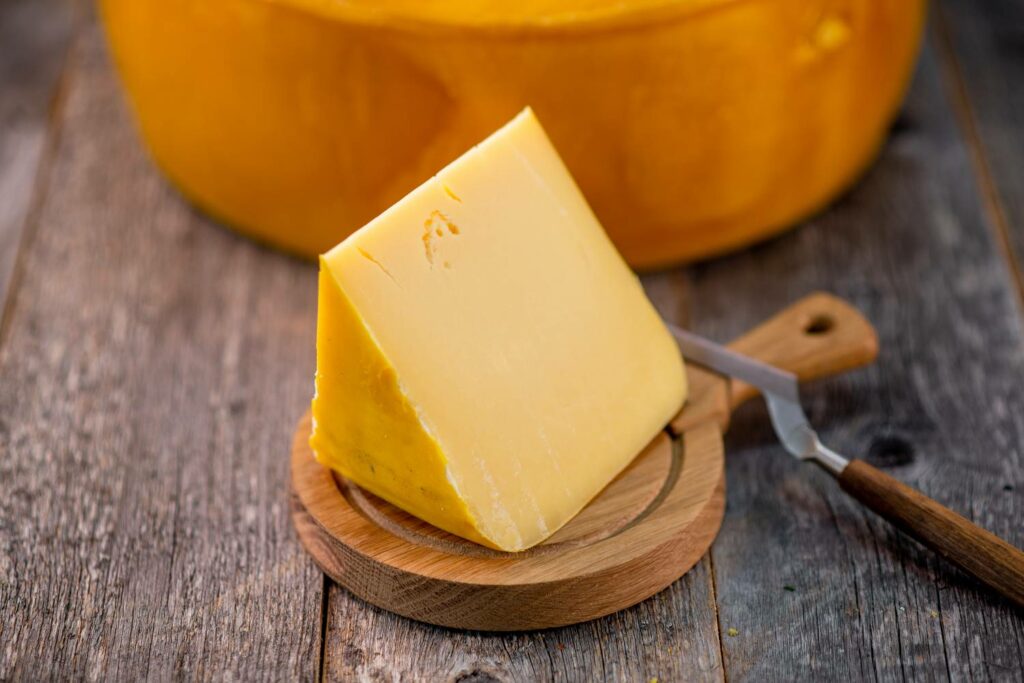
Gouda, a name that cheese lovers worldwide recognize and adore. This Dutch delight hails from the city of Gouda in the Netherlands, where it has been traded on the city’s cheese market for centuries. But Gouda is more than just a product; it’s a testament to time-honored traditions and craftsmanship, a rich piece of Dutch cultural heritage that has undeniably left its mark on the global culinary landscape.
What sets Gouda apart is its incredible versatility. Made primarily from cow’s milk, this semi-hard to hard cheese embarks on a fascinating journey as it ages. Young Gouda, aged for just a few weeks, offers a mild, creamy, and slightly sweet flavor that can add a touch of indulgence to your everyday sandwiches or pasta dishes.
But give Gouda some time, and you’ll witness an extraordinary transformation. Aged Gouda, left to mature for over two years, becomes a culinary masterpiece. It hardens, darkens, and develops an intense, caramel-like, nutty flavor that is nothing short of addictive. It’s this variant of Gouda that gourmet cheese boards yearn for, a taste that pairs exceptionally well with fruits, nuts, and a robust glass of your favorite wine.
Gouda’s distinct yellow-to-amber color and characteristic wax-covered rind are easily recognizable. The wax, often used as a canvas for color-coding based on the cheese’s age, encases the deliciously versatile cheese within.
Beyond its delightful taste, Gouda also packs a nutritional punch. It’s a good source of protein, calcium, and vitamins A and B12, making it not just a treat for your taste buds but also a wholesome addition to your diet.
What Does Gouda Taste Like?
Gouda has a unique and versatile flavor profile that changes dramatically as it ages.
Young Gouda, aged for just a few weeks to a couple of months, has a mild, creamy, and slightly sweet taste. It’s often described as having notes of butter and nuts. The texture at this stage is soft and smooth, making it a popular choice for melting in dishes or enjoying on sandwiches.
As Gouda matures, its flavor becomes more complex. Medium-aged Gouda, which is typically aged for 4-6 months, begins to develop a fuller, richer flavor with a firmer texture.
Aged Gouda, matured for a year or more, transforms into a hard, crumbly cheese with a deep amber color and a flavor that’s robust and complex. It develops a caramel-like sweetness, a slight hint of saltiness, and a nutty undertone. Some might even detect a hint of butterscotch in very old Gouda.
So, whether you prefer your cheese mild and creamy or rich and caramelized, there’s a Gouda for every palate.
Gouda Tasting Notes
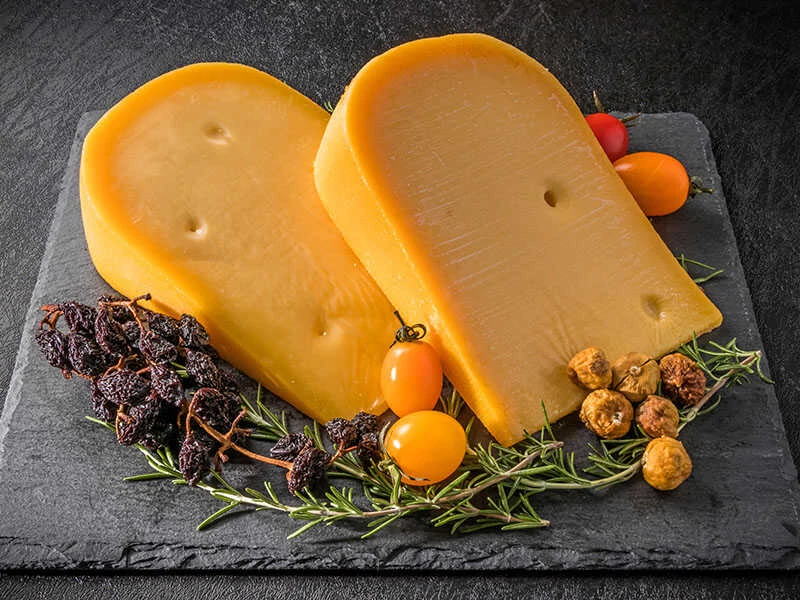
Young Gouda (aged for a few weeks to 2-3 months):
- Flavor: Mild, creamy, slightly sweet with hints of butter and nuts.
- Texture: Soft, smooth, and easy to cut or spread.
- Color: Pale yellow.
- Ideal Pairings: Light beers, white wines, fresh fruits, and mild meats.
Medium-aged Gouda (aged for 4-6 months):
- Flavor: Fuller and richer than young Gouda, with a balance of creaminess and nuttiness.
- Texture: Firmer than young Gouda but still relatively smooth.
- Color: Slightly darker yellow.
- Ideal Pairings: Heavier beers, medium-bodied wines, dried fruits, and stronger meats like salami.
Aged Gouda (aged for a year or more):
- Flavor: Robust and complex, with a caramel-like sweetness, slight saltiness, and nutty undertones. Some might even detect a hint of butterscotch in very old Gouda.
- Texture: Hard and crumbly.
- Color: Deep amber.
- Ideal Pairings: Strong, full-bodied wines, dark beers, dark chocolate, and robust meats like prosciutto.
>> Click here to read our in-depth guide on Aged Gouda
What is the Difference Between Gouda and Cheddar?
| Category | Gouda | Cheddar |
|---|---|---|
| Origin | The Netherlands, specifically the city of Gouda. | England, specifically the village of Cheddar in Somerset. |
| Production Process | After curdling, the whey is drained off and some water is added back to wash the curds, reducing the lactose content. | Involves a step called “cheddaring” where the curds are cut into blocks and stacked to press out the whey. |
| Flavor | Young Gouda has a mild, creamy, slightly sweet taste. As it ages, it develops a caramel-like sweetness and nutty undertones (source: Slurrp). | Typically has a rich, nutty, and sharp taste that intensifies as it ages. Sometimes it can have a slight hint of bitterness (source: Tasting Table). |
| Texture | Ranges from soft and creamy in young Gouda, to hard and crumbly in aged Gouda. | Generally has a firm and crumbly texture, though younger cheddar can be a bit smoother. |
| Aging | Can be eaten young or aged for several years. The age of the Gouda dramatically changes its flavor and texture. | Usually aged between 9 to 24 months, but some types of cheddar are aged for much longer. |
| Color | Typically has a yellow to amber color, depending on its age. | Natural cheddar is usually white to pale yellow. Some cheddars are dyed with annatto to give them a distinctive orange color. |
| Milk Used | Traditionally made from cow’s milk (source: Tabethas Table). | Can be made from cow’s milk as well as goat’s milk or sheep’s milk. |
>> Click here to read our in-depth guide on Cheddar
What is so Special About Gouda?
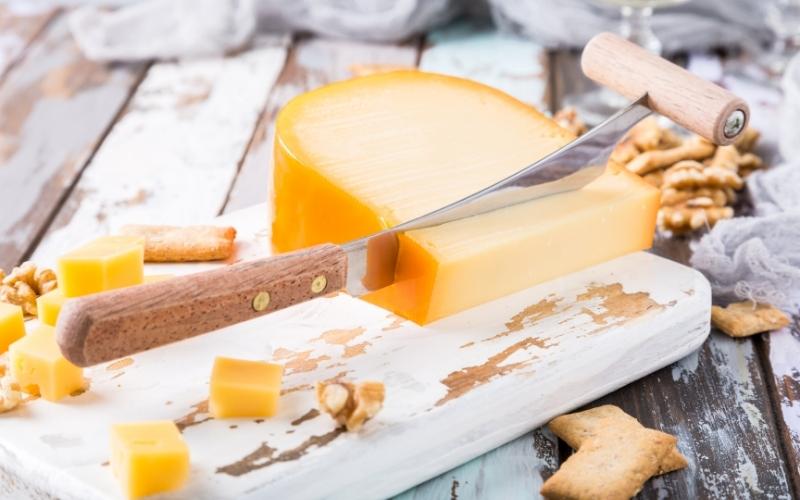
- Historical Significance: Gouda has been produced since at least 1184, making it one of the oldest recorded cheeses in the world still made today.
- Nutrition: Gouda is a highly nutritious cheese. It’s high in both protein and fats while being low in carbohydrates, making it a keto-friendly option. Additionally, it provides 70% of the daily value of calcium.
- Unique Production Process: The traditional process of making Gouda involves washing the curd, which reduces the lactose content and gives Gouda its characteristic sweetness.
- Versatility: Young Gouda is mild and sweet with a high moisture content and a smooth texture, making it a great table cheese for everyday eating. As Gouda ages, it develops a caramel-like sweetness and nutty undertones, becoming a robust, flavorful cheese that can be paired with strong, full-bodied wines and robust meats.
- Popularity: Gouda is probably the most popular cheese in the Netherlands, indicating its wide acceptance and love among cheese enthusiasts.
- Variety: Gouda can be produced in various sizes, including “baby Goudas” which are smaller wheels of 10 to 20 ounces, offering consumers a variety of choices depending on their needs.
What is the Difference Between Gouda and Smoked Gouda?
Gouda and Smoked Gouda are the same type of cheese, but they differ in their preparation and flavor profiles due to the smoking process.
Preparation:
- Gouda: Traditional Gouda is made by curdling milk, draining off the whey, and adding some water back to wash the curds. This process reduces the lactose content and gives Gouda its characteristic flavor. The cheese is then aged for varying lengths of time.
- Smoked Gouda: After the traditional Gouda-making process, Smoked Gouda is smoked in brick ovens over hickory or wood chips. This additional step gives the cheese its distinctive smoky flavor. The cheese also takes on a darker color from the smoke.
Flavor:
- Gouda: The flavor of Gouda depends on how long it’s aged. Young Gouda is mild and slightly sweet, while aged Gouda develops a caramel-like sweetness and nutty undertones.
- Smoked Gouda: Smoked Gouda has all the flavors of regular Gouda with an additional layer of smokiness. The smoking process also often results in a slightly firmer texture.
Uses:
Both types of cheese can be used in a variety of dishes, but their different flavors may make one a better choice than the other depending on the recipe. Regular Gouda can be used in anything from sandwiches to macaroni and cheese, while Smoked Gouda’s unique flavor makes it great for dishes where a smoky flavor is desired, such as in quiches, grilled cheese sandwiches, or smoked meat dishes.
>> Click here to read our in-depth guide on Smoked Gouda
Is Gouda a Healthy Cheese?
Gouda cheese is considered relatively healthy when consumed in moderation. It’s important to note that while it does contain high levels of saturated fat, it also boasts a wealth of other nutrients that contribute to its health benefits.
Nutritional Content:
- Gouda is a good source of many essential vitamins and minerals. A 1-ounce serving provides 10% or more of the daily value for calcium and phosphorus, which are crucial for bone health.
- Gouda is also high in protein, contributing to muscle growth and repair.
- It contains vitamin K2, a nutrient that is often lacking in Western diets but is critical for heart and bone health.
Health Benefits:
- Gouda can contribute to healthy teeth when eaten after meals due to its calcium content and low lactose levels, which have been shown to protect against tooth decay.
- The high calcium content in Gouda increases bone density and reduces the risk of osteoporosis.
Considerations:
- Despite its nutritional benefits, Gouda is high in calories and saturated fats. A 1.5-ounce serving contains approximately 151 calories, making it something to enjoy in moderation particularly if you are mindful of your calorie intake.
Gouda can be part of a balanced diet. As with all foods, it should be consumed in moderation. If you have specific dietary concerns or health conditions, it’s always best to consult with a healthcare professional.
How Do You Eat Gouda?
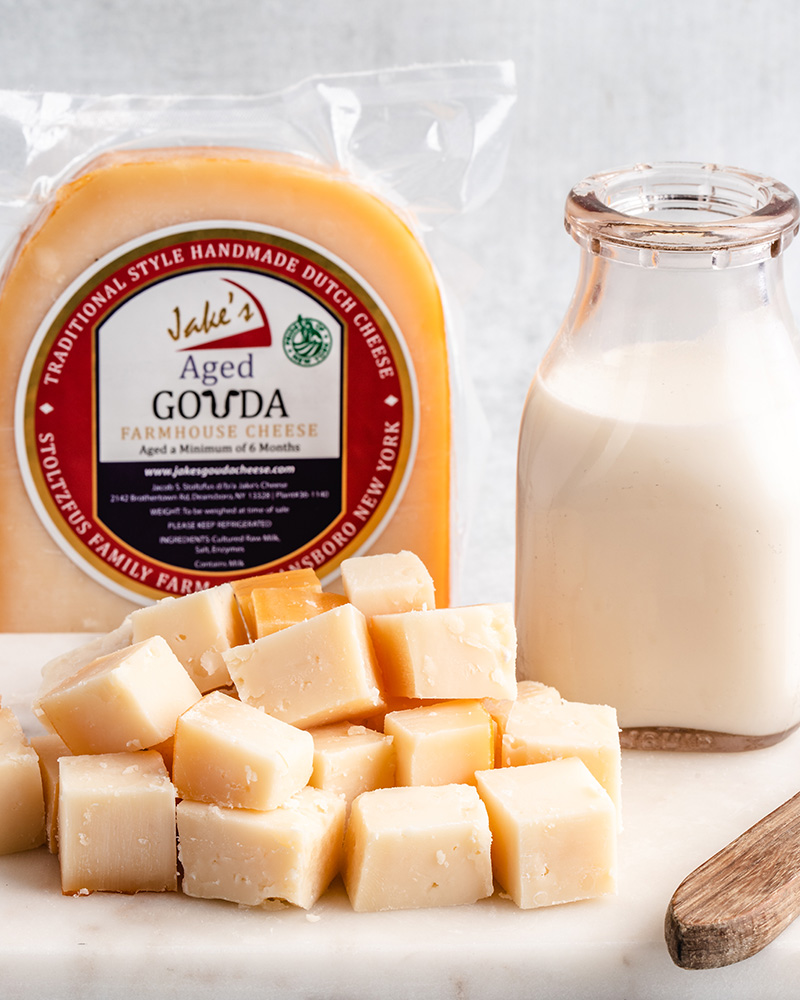
- On its own: Gouda can be enjoyed simply sliced or cubed as a snack. Pair it with fruits like apples or grapes for a delightful combination of flavors.
- Cheese board: Include Gouda on a cheese board along with a variety of other cheeses, cured meats, olives, crackers, and fruits.
- Cooking: Gouda melts well, making it a great choice for dishes like grilled cheese sandwiches, macaroni and cheese, or cheeseburgers.
- Baking: It can be used in cheese-based pastries or sprinkled on top of casseroles or baked pasta dishes.
- Salads: Cube or shred Gouda and sprinkle it over salads for a rich, creamy addition.
- Soups: Gouda can be melted into soups to add depth and creaminess. It pairs well with tomato, potato, and broccoli soups.
- Pairing with drinks: Young Gouda pairs well with lighter wines like Chardonnay or Sauvignon Blanc, while aged Gouda can stand up to more robust wines like Merlot or Cabernet Sauvignon. Gouda also pairs well with beers like pale ales and stouts.
7 Best Gouda Cheese Substitutes
| Cheese | Reason for Substitution |
|---|---|
| Edam | Edam has a similar mild, slightly sweet and nutty flavor to young Gouda. Its texture is also quite similar, making it a good substitute for cooking or on a cheese board. |
| Havarti | Havarti is a Danish cheese that has a buttery aroma and taste, much like Gouda. It melts well, so it can be used in a variety of hot dishes. |
| Jarlsberg | Jarlsberg is another cheese with a nutty flavor and large holes. It’s a good substitute for Gouda in sandwiches, salads, and baked dishes. |
| Fontina | Fontina has a creamy texture and a slightly nutty flavor. It melts beautifully, making it a great substitute for Gouda in dishes like macaroni and cheese or grilled cheese sandwiches. |
| Muenster | Muenster is a smooth, moist cheese with a mild flavor. It’s a good substitute for Gouda in recipes where you want a cheese that melts well. |
| Mild Cheddar | Mild cheddar has a similar level of creaminess and a slightly stronger flavor, but it can work as a substitute in most dishes that call for Gouda. |
| Monterey Jack | Monterey Jack has a mild flavor and good melting properties. It can replace Gouda in dishes like quesadillas, casseroles, and other hot dishes. |
What Pairs Well With Gouda?
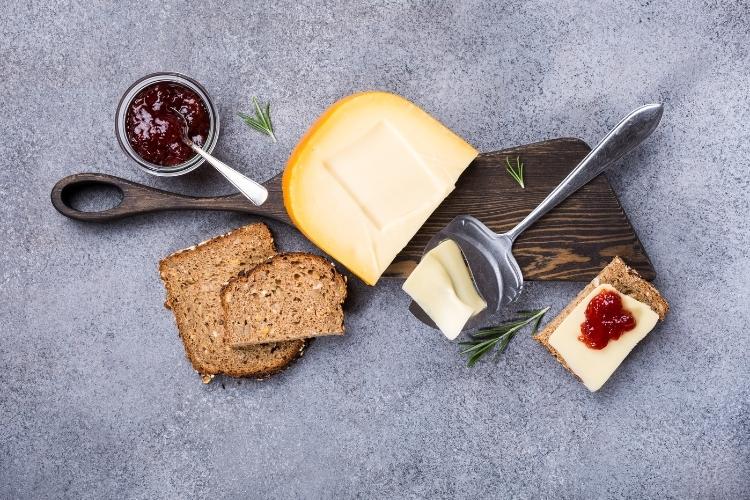
Food that goes well with Gouda:
| Category | Food Pairings with Gouda |
|---|---|
| Fruits | Apples, Pears, Apricots, Cherries, Grapes, Dried Fruits |
| Breads | Sourdough, Crusty Bread, Potato Bread |
| Meats | Ham, Sausage |
| Vegetables | Zucchini, Cauliflower, Spinach |
| Sweets and Nuts | Dark Chocolate, Honey, Roasted Almonds |
| Others | Crackers, Mustard |
Also read: What Fruit Goes on a Charcuterie Board?
Beverage that goes well with Gouda:
| Category | Beverage Pairings with Gouda |
|---|---|
| White Wine | Chardonnay, Riesling, Sauvignon Blanc |
| Red Wine | Merlot, Cabernet Sauvignon, Pinot Noir |
| Beer | Pale Ales, Stouts, Brown Ales, Belgian Ales |
| Spirits | Whiskey, Brandy |
| Non-alcoholic | Apple Cider, Grape Juice, Herbal Tea |
Also read: Best Wine and Cheese Pairings: The Ultimate Guide
The History and Origin of Gouda: A Journey Through Time
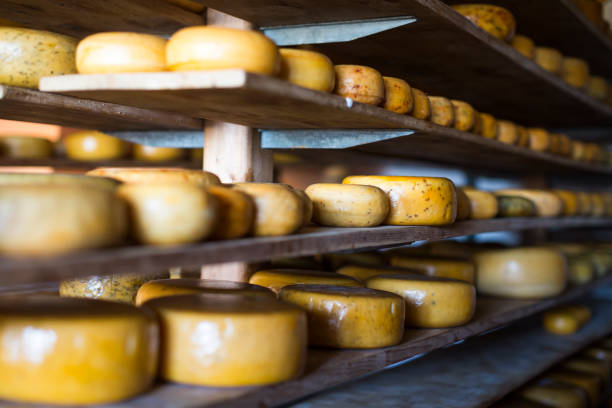
The Birth of Gouda
Historical records trace the production of Gouda back to the 12th century, making it one of the oldest surviving types of cheese. The term “Gouda” is not restricted to cheese of Dutch origin, but the traditional, authentic Gouda that we know and love today is indeed Dutch. The cheese must be made from untreated milk and prepared according to certain historical standards.
Cultural Significance
The cheese markets in Gouda city are iconic tourist attractions where the traditional method of cheese trading by ‘handjeklap’ or clapping hands is still performed.
Gouda holds a special place in Dutch celebrations and traditions. It is often the star at Christmas markets, family gatherings, and social events. Its popularity is such that there’s even a museum dedicated to it – the Gouda Cheese Museum, which showcases the history and production of this beloved cheese.
Beyond the Netherlands, Gouda’s influence extends globally. It is one of the most popular and widely consumed cheeses worldwide, appreciated for its creamy texture and rich flavor. This Dutch export has found a place in various international cuisines, from gourmet recipes in France to comfort food in America.
Gouda also plays a significant role in the Dutch economy. The Netherlands is the largest cheese exporter in the world, with Gouda being one of its leading exports.
The Evolution of Gouda
From its humble beginnings in the 12th-century Dutch dairy farms to its esteemed position on the global culinary stage, Gouda cheese has undergone a fascinating evolution. Initially traded in the city of Gouda, from which it got its name, this semi-hard cheese has transcended borders, becoming a cherished delicacy worldwide.
Over the centuries, producers have experimented with the aging process, giving birth to variants ranging from the creamy, mild young Gouda to the intensely flavorful, hard-aged Gouda. Even as production methods have modernized, many cheese makers still honor the traditional techniques, preserving Gouda’s rich heritage.
Today, Gouda stands not just as a testament to Dutch culinary prowess, but also as a symbol of how food can evolve, adapt, and spread, connecting cultures across time and space.
Gouda in Today’s Food Culture
In today’s global food culture, Gouda has carved out a niche for itself as a cheese of choice for both casual and gourmet dining. You’ll find Gouda adding a rich, melty decadence to burgers and grilled sandwiches, providing a savory contrast in sweet pastries, or lending depth to pasta dishes and casseroles.

Frequently Asked Questions
1. Does Gouda cheese melt easily?
Yes, Gouda cheese does melt easily. The melting potential of Gouda cheese is dependent on its age. Younger Gouda, often distinguished by a red wax coating, melts brilliantly due to its higher moisture and fat content. It can lend a smooth, creamy texture to sauces and can even replace cheddar in several dishes.
However, as Gouda ages, it loses moisture, becoming harder and less likely to melt into a gooey consistency. Aged Gouda will still melt but expect it to wilt rather than stretch. This makes it ideal for topping dishes like pasta where a full melt isn’t necessary.
In terms of flavor, smoked Gouda is an excellent choice for dishes like a tuna melt, where its smoky flavor complements the savory taste of the tuna.
2. Is Gouda good for grilled cheese?
Yes, Gouda is a good choice for grilled cheese. Its smooth melting quality, especially in younger Gouda, makes it an excellent filler for these sandwiches. The nutty and caramel-like flavor of Gouda also adds a unique twist to the classic grilled cheese.
If you’re feeling adventurous, you could even try a deep-fried or shallow-fried Gouda with a thick batter for a different texture.
3. Why is Gouda so salty?
The saltiness of Gouda cheese, like many other types of cheese, is due to the cheese-making process. During production, cheeses are often brined, which means they’re soaked in a solution of water and salt. This process gives the cheese flavor, helps form the rind, and acts as a preservative to extend the cheese’s shelf life.
Gouda is typically brined for a longer period, which can lead to a higher salt content. The specific saltiness can vary depending on the length of the brining process and the age of the cheese. For instance, younger Gouda tends to be milder and less salty than its aged counterparts.
Moreover, salt plays an essential role in developing the texture and taste of the cheese during the aging process. In the case of Gouda, the salt helps create its signature creamy, semi-hard texture and distinct flavor.
Also read:
- What is Robiola? A Taste of Piedmont, Italy
- All About Roquefort: An Insider’s Guide to the King of Blue Cheese
- What is Cooper Sharp Cheese? A Taste of Tradition
- What is Pepper Jack Cheese? The Spicy Star of American Dairy
- What is American Cheese? The Controversial Delight of the Dairy World
- Emmental: A Comprehensive Guide to Switzerland’s Cheese Haven
- What is Oaxaca Cheese? A Staple in Mexican Cuisine
